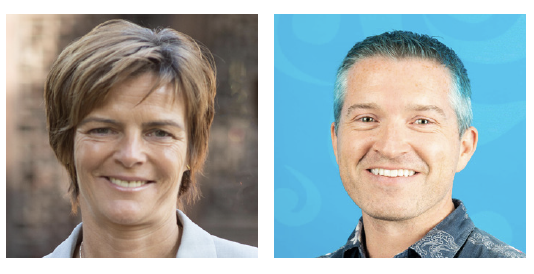Leveraging student voice for a new world
Marta Medved Krajnovic
and Stephen Taylor
Western Academy of Beijing
This article first appeared in the June issue of International School Leader.
At a recently hosted TEDx at Western Academy Beijing (WAB), eight students shared ideas that were informed or inspired by the coronavirus outbreak. Topics ranged from innovation in biotechnology to music production at home, to learn more about what we are as humans and how we react when faced with a global crisis.
Research is confirming that being empowered, having voice and choice, and working together increases not only engagement, motivation and learning, but also student well-being. It is not just special events that create the opportunities for student agency to drive the learning in our schools. That journey of ‘students in the centre’ started at WAB through our founding values and, over time as an International Baccalaureate continuum school, we have incorporated it into all stages of our teaching, learning and school development.
Student voice and choice in daily learning
Even our youngest learners in Elementary have choice and voice, from how they connect with a unit of inquiry to the opportunities to co-create their daily schedule. In Grade 3, students engage with a prompt, “what did I do well this week and what do I need to spend more time on”, and then based on their responses they allocate part of their schedule to focus on this area. In Middle School, our student surveys have become a continuous collaborative effort with the Middle School student council. They work with school leadership to co-create the questions and analyse the results. Questions cover teaching, social-emotional support and inclusion, and the responses inform our planning for the coming year. In the Middle and High Schools, we have a nine-day rotation in our schedule. On Day 9 students have full freedom of choice on how to build the most inspiring and helpful day for them. Choices include academic, social, physical, leadership or creative options. Students also have the opportunity to lead workshops for their peers and teachers. Another example of student agency is Grades 6–9 Maths. During these lessons, students can choose whether they want to work in groups or individually, the space they think is most conducive to learning and whether they would like self- or teacher-directed instruction.
Student voice events at WAB
TEDx is not the only event where students have the opportunity to share their voices. When planning our global conference, students have played an integral role. At the Future of Education Now (FOEN) 2019 conference at WAB, students were supported with a facilitated stream over the three days where they could join workshops and speaker sessions. The conference culminated with a student-led closing keynote where they shared their vision of the future of education.
Student voice in the design of space
As spaces at WAB are changed to better support learning and well-being, so our students have a voice in the design. For their new Middle School playground, the student council surveyed and ran focus groups with fellow students on what they would like. Their feedback resulted in a tailor-made space that is used not only for play but also as a dynamic learning environment.
“We are facing not only a public health emergency with COVID-19, but also an economic and climate emergency… I can’t vote for another five years, and neither can my friends, but my family, teachers and politicians can invite more of us into their conversations about how we envisage our world. So, before you ask us the question “what do you want to be when you grow up,” ask us the question, “what kind of world do you want to live in.” We need everyone, adults and children in this fight for a better future and the only way to do that is together.” – Jeremy. Grade 8 TEDx speaker
“Perseverance has become almost like a ‘hello’ part of our daily conversations. But contrary to its usual connotation, our constant need to persevere has shown us that we can transform it into creativity, wellbeing, and fulfilment. With our speakers and audience spread across the globe last year, we took on the challenge to host an online event. Despite the physical distance, it brought us as an organising team closer, and showed us how we can transform our stress and fear of the unknown into a movement for empowering student voices and learning. We turned our resilience into passion, which has, in turn, become a part of our well-being.” – Katarina. Grade 12 TEDx leader.
In our High School, a Design in Service (DIS) student group has been working with the leadership team to redesign the outdoor spaces of the campus and to purchase new furniture. As part of the refurbishing of the High School, a sample classroom was set up and students and teachers tested furniture and gave feedback. Their feedback was the basis on which the final decisions were made.
Student leadership and voice in strategic planning
In 2016, in the process of creating the WAB 2017–2021 strategic plan and envisaging our innovative education strategy (later named FLOW 21), students across all school sections were already quite articulate about what kind of school experiences they would like to see. They wanted greater control over what, when and how they learned; they wanted their work to be meaningful and relevant, and they wanted passionate and engaged teachers.
Five years down the road, in the midst of a global pandemic, and with the complexity, disruption and grief it has brought, we feel an even deeper urge to engage our students in interdisciplinary, transformative, creative and joyful learning that will help them better understand and navigate a complex world. However, isn’t it presumptuous to think that we are the ones who can help students understand the world around them? Maybe they are the ones who can help us understand it better and discover what we need to learn and do to help our students “find their voices to create a world as it could be, should be, might be, what we hope it will and what we hope it won’t be” (Steve Sostak, Inspire Citizens).
Guided by that thought, from being only one of the voices in our strategic planning five years ago, this time around our students are leading WAB 2021 strategic planning and engaging the whole school community – their peers, their teachers, their parents – in designing ‘Portraits of WAB Alumni’. They are change-makers that will leave WAB with a sense of agency and empathy, voice and confidence.
Giving students voice and choice can be uncomfortable as we cannot predict what student voices will raise, what choices they will make, what disruption will happen in some of the ways we approach teaching and learning. Nevertheless, at WAB we firmly believe that the synergy between student agency and our school mission, and our willingness to listen and learn together, are our best guarantee that WAB alumni are future-ready.
What do you think about the points raised in this article? We’d love to hear your feedback.

ABOUT THE AUTHORS
Dr Marta Medved Krajnovic is Head of School and Stephen Taylor is Director of Innovation in Learning and Teaching at Western Academy of Beijing.
Connect with them on LinkedIn: Dr Marta Medved Krajnovic and Stephen Taylor.










